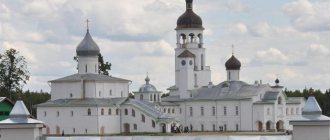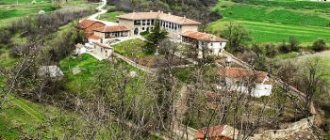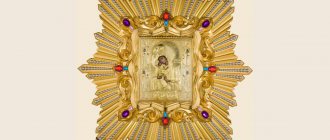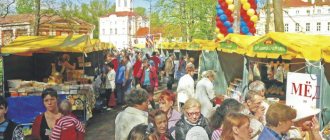Meanings of the word laurel. What is laurel?
Lavra
Lavra (Greek Λαύρα - city street, crowded monastery) is the name of some of the largest Orthodox monasteries for men.
en.wikipedia.org
Lavra (Greek: “crowded place”) is the name of some of the most important and large monasteries. In the V – VI centuries. in Palestine, this was the name given to monasteries protected by walls from attacks (for example, the Lavra of St. Sava the Consecrated).
Orthodox encyclopedia "ABC of Faith"
Lavra (Greek “street, village”) - in ancient times, a structure of monastic life, average between strict hermitage (skete) and strict community (monastery): a joint settlement not bound by strict regulations.
www.vidania.ru
Kiev-Pechersk Lavra
Kievo-Pechersk Lavra (Ukrainian: Kievo-Pecherska Lavra) is one of the first monasteries founded in Kievan Rus. Founded in 1051 under Yaroslav the Wise by monk Anthony, originally from Lyubech.
en.wikipedia.org
KIEV-PECHERSKAYA LAVRA is one of the largest and richest Russian. monasteries, considered “the oldest in its glory.” Its founder was Rev. Anthony, and the organizer was Rev. Feodosius. Anthony labored twice on Mount Athos...
Humanitarian Dictionary. — 2002
The Kiev Pechersk Lavra is located on the southern tip of Kyiv, on the right, high bank of the Dnieper, and occupies two hills, separated by a deep hollow descending to the Dnieper.
Encyclopedic Dictionary F.A. Brockhaus and I.A. Efron. — 1890-1907
TRINITY-SERGIUS LAVRA
TRINITY-SERGIUS LAVRA, the famous Russian (monastery) monastery; entered into tradition as a monumental historical symbol of Orthodoxy as such (for some time it was also the center of the Russian Orthodox Church).
Encyclopedia Around the World
TRINITY-SERGIUS LAVRA is a Russian monastery founded by the church. and political figure Sergius of Radonezh (in the world Bartholomew) c. 1330-40. The first abbot of the monastery was Mitrofan (who tonsured Sergius).
Soviet historical encyclopedia. — 1973-1982
Holy Trinity Lavra of Sergius (Trinity Monastery) is a famous monastery founded by Sergius of Radonezh in 1337. For centuries, the Trinity Lavra of Sergius has been one of the most revered all-Russian shrines...
Brief historical dictionary. — 2000
Trinity-Sergius Lavra
The Trinity-Sergius Lavra, in church literature usually the Holy Trinity-Sergius Lavra, is the largest Orthodox male stauropegial monastery in Russia (ROC), located in the center of the city of Sergiev Posad, Moscow region, on the Konchura River.
en.wikipedia.org
Trinity-Sergius Lavra, famous Russian monastery, Moscow province, Dmitrovsky district, 68 years ago. from Moscow. Founded by St. Rev. Sergius (q.v.) around 1335. At that time there were dense forests all around; there was no road...
Encyclopedic Dictionary F.A. Brockhaus and I.A. Efron. — 1890-1907
Trinity-Sergius Lavra, the largest Russian monastery. Located 71 km north of Moscow in modern Zagorsk. Founded in the mid-14th century. Sergius of Radonezh. Construction in 1540-50 of stone walls with 12 towers...
TSB. — 1969—1978
Alexander Nevsky Lavra
The Holy Trinity Alexander Nevsky Lavra is a male Orthodox monastery on the eastern end of Nevsky Prospekt in St. Petersburg. The first and largest monastery in the city. Since 1797 it has had the status of a monastery.
en.wikipedia.org
ALEXANDRO-NEVSKY LAVRA, monastery and museum in St. Petersburg. The monastery was founded by the will of Peter I in memory of St. Alexander Nevsky in 1710 on the banks of the Neva. By decree of Paul I it was renamed the Lavra. With the construction of canals, its territory turned into the so-called.
Encyclopedia Around the World
ALEXANDRO-NEVSKY LAVRA, a monastery in St. Petersburg (since 1797 Lavra). Founded in 1710 in memory of the victory of Prince Alexander Yaroslavich over the Swedes in the Battle of the Neva in 1240.
Modern encyclopedia. — 2000
Alexander Nevsky Lavra (Alexander Nevsky Square, 1; embankment of the Monastyrka River, 1), former monastery, historical and artistic monument. Located at the end of Nevsky Prospekt, between Alexander Nevsky Square and the Obvodny Canal...
Encyclopedia of St. Petersburg. — 1992
Alexander Nevsky Lavra Resurrection” by J. X. Rubens; in the altar - “Annunciation to St. Bogorod." Raphael Mengs). Behind the right choir there is a silver shrine with the relics of St. Alexandra N., built by the emperor.
Encyclopedic Dictionary F.A. Brockhaus and I.A. Efron. — 1890-1907
Alexander Nevsky Lavra Alexander Nevsky Lavra in Leningrad, an architectural monument; former monastery. Founded by Peter I in 1710 in memory of Alexander Nevsky; in 1797 it was transformed into a lavra (a large male Orthodox monastery).
Popular art encyclopedia. — 1986
Pochaev Dormition Lavra
Pochaev-Assumption Lavra, Pochaev Lavra, monastery (until 1833) in the village of Pochaev (now Kremenets district, Ternopil region). It was first mentioned in sources in the 16th century. The owner of the village of Pochaeva - Goyskaya in the mid-16th century.
TSB. — 1969—1978
POCHAEV ASSUMPTION LAVRA, the second Orthodox (monastery) monastery in Ukraine in terms of its historical and ecclesiastical status (after the Kiev Pechersk Lavra). Located in the town of Pochaev, Ternopil region (formerly Volyn province), on a high hill.
Encyclopedia Around the World
POCHAEV ASSUMPTION LAVRA - famous in Russia. Empire 2nd half. 19th century Orthodox monastery located in Volyn. The first monks. settlements on the site of the future P.U.L., according to legend, appeared in 1240...
Humanitarian Dictionary. — 2002
Laurel
Laurel (Laurus nobilis L.). An evergreen shrub or tree of the laurel family. Homeland: Asia Minor Peninsula, Eastern Mediterranean. Bred in all countries of Southern and Western Europe, North Africa, the Middle East...
Pokhlebkin V.V. Great Encyclopedia of Culinary Arts
Laurel (lat. Laurus) is a genus of subtropical trees or shrubs of the Laurel family (Lauraceae). Representatives of the genus grow in the Mediterranean, the Canary Islands and Western Transcaucasia. Evergreens.
en.wikipedia.org
LAUREL is a symbol of triumph, victory and success. The laurel serves as the emblem of Apollo, the Greek god of the sun, poetry and music. Pursued by the loving Apollo, the nymph Daphne turns into a laurel bush - the tree turns out to be in the arms of the god...
Symbols, signs, emblems. — 2005
Laurel (Greek daphne, Latin laurus). L. was brought to Europe, apparently from M. Asia. Theophrastus already noted the abundance of laurel trees in Greece. In antiquity, L. was used for a variety of purposes.
dictionary_of_ancient.academic.ru
Laurel. It was brought to Europe, apparently from M. Asia. Theophrastus already noted the abundance of laurel trees in Greece. In antiquity, L. was used for a variety of purposes. In everyday life, bay leaves were used to fumigate a room because of its pungent aroma.
drevniy_mir.academic.ru
Noble laurel
Laurel (lat. Láurus nóbilis) is a subtropical tree or shrub, a species of the genus Laurus (Laurus) of the Laurel family. Its leaves are used as a spice (bay leaf). From the name of this plant came the names Laurus, Lavrentiy, Laura, Lorenz...
en.wikipedia.org
Laurus nobilis L. Laurel family. An evergreen tree up to 18 m high, with brown, smooth bark and bare shoots. The crown is densely leafy, predominantly pyramidal in shape.
Goncharova T.A. Encyclopedia of medicinal plants. — 1997
Russian language
Laurel/a (monastery).
Morphemic-spelling dictionary. — 2002
Comparison
In addition to the above-mentioned cinnovia and idiorhythm, there are monasteries of other types in Orthodoxy. For example, deserts (accent on the first syllable), of which the most famous is Optina Pustyn in the Kaluga region. Despite its antiquity (founded at the end of the 14th century) and great significance for Orthodoxy (the desert was visited during spiritual quests, for example, by Leo Tolstoy and Fyodor Dostoevsky), it did not receive the status of a monastery. But it has the status of a stauropegic monastery - this means that it is subordinate not to the local diocese, but directly to the Patriarch.
And the Trinity-Sergius Lavra (which also has the status of a stauropegial monastery) has repeatedly performed a state-preserving role. It was here that Sergius of Radonezh blessed Dmitry (who would only later be called Donskoy) for the Battle of Kulikovo. At the beginning of the 17th century, the monastery withstood almost a year and a half siege by Polish invaders and became one of the strongholds of the militia of Minin and Pozharsky. And at the end of the same century, first Princess Sophia and then Peter the Great would flee here, fleeing from the Streltsy riots. And from here he went back to Moscow in 1689 - already the sovereign ruler of the Russian kingdom.
Care
It is advisable to place the bay tree on the south or east sides. Adult plants are not afraid of direct sunlight, but young plants need to be periodically shaded from bright light.
Water the soil in pots every 2-3 days, not allowing the soil to dry out . You should only use soft, settled water at a temperature of +20–24 °C. The ground cannot be swamped; excess moisture is removed. To do this, there should be not one, but several holes in the bottom of the pots; it is advisable to loosen the soil surface regularly.
It is recommended to humidify the air in the room, especially in winter, during the heating season. It is useful to spray the foliage with a spray bottle 1-2 times a week.
In the first year after planting, it is not necessary to feed the crop . From the second year you can gradually add organic matter and mineral fertilizers. It is recommended to add leaf humus, nitrogen and phosphorus-potassium mixtures. Fertilizing should be combined with watering so that nutrients immediately penetrate deep into the soil. Fertilizer frequency: 1–2 times per growing season.
You can prune the laurel as soon as it has gained sufficient green mass . The plant tolerates haircuts well, does not wither and does not get sick. However, its slow growth should be taken into account: it is recommended to remove no more than ⅛ of the length per year, otherwise the crown will take a long time to recover.
Since October, the laurel is gradually transferred to winter mode. The frequency of watering is reduced, fertilizing is stopped, and the temperature is gradually reduced to +12 °C. Until March, the culture is kept in a cool but well-lit room.
Young laurel is transplanted in the third year of life . The soil is changed completely, the container is selected 2-3 cm wider than the previous one. Starting from the age of 3, the bush is moved to a new container every 3–4 years.
Where does it grow
The bay tree prefers a warm subtropical climate with winter temperatures of at least 8–10 °C. Laurel nobilis grows in:
- Italy,
- Greece,
- Spain,
- Turkey,
- Transcarpathia,
- Transcaucasia,
- Crimea,
- Krasnodar region.
The Azores species is common in the Canary and Azores Islands, Madeira. Camphor laurel is dominant in Asia:
- southern part of China,
- Japan,
- Taiwan,
- India,
- Korea,
- Vietnam.
Distributed and cultivated in East and North Africa, the southern states of America, Mexico and Brazil, and the fertile territories of Australia.
Application
Laurel trees are used for landscaping gardens and home areas in regions with a suitable climate. They can be grown as indoor and greenhouse crops.
The leaves, due to the content of essential oil, which has a subtle bitter aroma, are used to flavor canned meat and vegetable products . Whole or ground into powder, they are included in spicy mixtures, brines, sauces, and marinades. The preparation of roast, pilaf, goulash, jellied meat, fish and meat casseroles, and soups is incomplete without bay leaf.
Bitterness, resins and oils of laurel are used in pharmacology and folk medicine. Camphor, isolated from the leaves and wood of the same species, is included in liniments, ointments and solutions for anesthesia for injuries, rheumatic and dermatological diseases, irritations and inflammations. Essential and fatty oils have an antiseptic, astringent, sedative, regenerating, and hypoglycemic effect.
An infusion of bay leaves is used to alleviate well-being in case of neuroses, migraines, neuralgia, arthralgia, muscle pain, diabetes, and arrhythmias. Extracts and ointments based on laurel oil are used to anesthetize poisonous insect bites and eliminate boils.
Diseases and pests
The laurel reacts to a lack of moisture by drying out and yellowing of the foliage. Young plants may turn pale when exposed to too much sun. Root waterlogging threatens the tree with root rot. Its signs: withered greenery, stunted development. Laurel is resistant to fungal attack due to the large amount of its own antiseptic substances.
Among the pests that are dangerous to the plant are scale insects, spider mites and mealybugs . You can detect them by examining the leaves. Signs of the presence of parasites: brown plaques, sticky whitish plaque or greenery entangled in thin threads. In addition to insecticides, you can use home remedies: wash the leaves with soap, soda solution, water and alcohol infusion of garlic. Sick specimens are isolated in a separate room, and the bottom layer of soil is replaced. Sometimes a complete change of container and soil is required. Before planting in a new place, the roots of the bush are washed with a solution of potassium permanganate.
Transfer
How to care for laurel, fertilizing and replanting
In the first year of life, the laurel seedling will feel good without additional nutrition. But already in the second year it will need to be fed. To provide the plant with a little mineral fertilizer, it will be enough. They are paid monthly.
Laurel does not particularly suffer from poor soil. The only thing it cannot tolerate is excess moisture in the ground.
The laurel tree grows slowly. When kept in containers, trees need to be replanted periodically. Young animals are transplanted often - every couple of years. When replanting, take a pot 2 cm wider than the old one. For older trees, the pot is changed after 3-4 years.
Laurel pots
Laurel will respond gratefully not only to mineral, but also to organic fertilizers. You can use pigeon droppings diluted with water and infused. Sometimes they also use diluted slurry. Mineral and organic fertilizing should be alternated. Before applying fertilizer, the soil must be thoroughly wetted so as not to burn the roots.
Composition of laurels
Replanting should not be done frequently. You should not choose a large container for a small tree. The plant feels best in a small pot. When it becomes crowded, the new container should be 4 centimeters larger. Replanting should be done by transferring the earthen clod, adding the necessary soil into a new pot. After planting, the laurel must be watered. Transplantation can be done in spring and summer.
Landing
In the middle zone, it is recommended to grow laurel only indoors. One of the compromise options is to plant in pots or tubs, which can be exposed in the fresh air in the summer and brought indoors in the fall.
You can get a beautiful indoor culture from seeds . It is recommended to sow them in February or March. The seed material is first freed from the fruit shell and soaked for 2–3 hours in a warm pink solution of potassium permanganate. The seeds are sprouted in a mixture of sand, soil and peat. They deepen the soil 1 cm, water it and cover the surface with film. Keep containers in a bright room at an air temperature of +20–24 °C. After the sprouts appear, the protection is removed.
Seedlings are planted into a separate bowl with the appearance of the first pair of leaves . The soil for them should be moderately fertile, loose, neutral or slightly alkaline. Mixtures of equal parts of leaf and turf soil with the addition of 25% of the total volume of peat, 5% of sand and moss are suitable. Containers for planting are chosen to be small: no more than 1.5 liters, taking into account the need for subsequent replanting of young plants. Drainage made of broken bricks or coarse river sand must be poured onto the bottom.
Story
In the 6th century in Palestine, laurels were the name given to large monasteries in which the independent life of the inhabitants was preserved (independent earning of money, handicrafts) in the presence of a joint arrangement of common needs (organization of worship, construction of a wall from attacks by Bedouin nomads). This form of organization distinguished the laurels from the cenobiums, where the main principle was a “communal” structure, implying joint ownership, general distribution of labor and benefits. Later, historically and spiritually significant monasteries were called laurels, regardless of the form of residence (cenovia or idiorhythm).
Beneficial features
To learn more about the healing properties of the plant, watch the video.
Bay tree has a long list of benefits. By growing it at home, you can get an excellent interior decoration and the opportunity to prepare a useful and popular spice – laurel leaves – with your own hands.
Laurel is a plant that even children will enjoy caring for, since it mainly depends on proper watering and location. If you do not know how to properly water an ornamental tree, then do it when the top layer of soil dries slightly. Do not overwater the flower, because even an unpretentious laurel can rot its roots from the abundance of water.
Before planting or transplanting, do not forget to do drainage. Try to refrain from transplanting a one-year-old laurel. The only thing this tree doesn’t really like is frequent replanting; its roots are very sensitive.
If you propagate a flower using cuttings, then when cutting, try not to completely cut the shoot from a large tree, try to carefully tear it. The resulting “heel” will contribute to faster development of the root system of the young seedling.
Do not forget about humidity and spray the plant daily in hot weather. Try to do this in the evening hours, since drops of moisture on the leaves, when exposed to sunlight, turn into very strong lenses that can leave severe burns on the foliage, which will lead not only to an unsightly appearance, but also to their death.
Do not feed the plant in winter during the dormant period, otherwise, during the natural time for active growth, the laurel will not be able to develop normally, since it will not have time to gain strength. In winter, it is also advisable to reduce watering.
Reproduction
In addition to the seed propagation method, cuttings and division of the bush are used. In the first case, the material is 7–9 cm segments of shoots that have not had time to fully lignify. It is recommended to take them from the middle or lower part of the plant; they can be harvested from April to mid-summer. The bottom cut should be made at an angle of 45°. Cuttings must be developed and contain at least two internodes. The leaves are torn off, leaving one pair, shortening the stem by half. Plant the material in a mixture of turf soil and ¼ part sand, deepening it by 2 cm. Care for it as for young plants. The root system appears in 1–2 months.
They resort to dividing the bush when it is necessary to rejuvenate an adult plant. This must be done during the dormant period - from October to January. It is recommended to separate a part with 2-3 shoots at a time, carefully cutting the rhizome.










